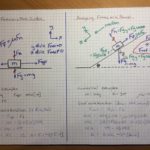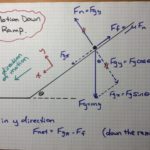SPH4UI Distance Learning
The following table contains an outline for material that will be covered through distance learning. Resources such as notes, worksheets, activities and quizzes will be posted as needed.
| Week # | Learning Goals and Essential Learnings | Resources |
|
Week 1 Apr 6-12 |
Survey the class to ensure everyone has the necessary tools to be successful in distance learning. Diagnostic Check on what students remember from grade 11 – grade 11 Review – Newton’s 3 Laws, Solving Newton’s 2nd Law problems |
optional practice – Newton’s Laws 1 Dim Review |
|
Week 2 Apr 13-19 |
Solving problems with forces in two dimensions. I have added a couple of videos to google classroom this week.
I have also included some reference material (see text book links) and reference images for students who want more details I would like you to try the activity in google classroom and submit whatever you can by the end of the week. Please also complete the weekly Exit Survey (links to the right) when you are done the activity.
|
Textbook Reference : Chpt2.1 Chpt2.2 Note : see video in google classroom and reference images below Google Classroom : see activity and video |
|
Week 3 Apr 20-26 |
Solving Problems Involving Multiple Objects This week we are looking at problems involving multiple objects. I have posted two sample problems to the right and videos showing how to solve these problems. You are encouraged to try these problems on your own if you feel confident. Otherwise, follow along with my solutions and then go back and try them on your own. This week’s activity has you building a modified Atwood machine and analyzing the forces and motion. I have included optional worksheets for anyone who wants extra practice solving these types of problems. As always, please also complete the weekly Exit Survey (links to the right). |
Textbook Reference : Chpt 2.3 Chpt 2.4 Sample Problems : Systems of Objects Lesson : Horizontal Motion Problem Atwood Machine Google Classroom : see activity and video |
|
Week 4 Apr 27-May 3 |
Uniform Circular Motion Determining the relationship between force and frequency for uniform circular motion. The learning goal this week is to understand what factors affect uniform circular motion (motion in a circle at a constant speed). There is no lesson this week as everything is contained within the activity in google classroom. For those students who are looking for extra work, a worksheet has been provided with formulas included. As always, please also complete the weekly Exit Survey (links to the right). |
Textbook Reference : Chpt 3.1 Chpt 3.2 Appendix A Google Classroom : see activity and video extra practice (optional) : Centripetal Worksheet |
|
Week 5 May 4-10 |
Problem Solving with Uniform Circular Motion Using centripetal motion formulas to solve dynamics problems. I have inlcude two videos this week as the introduction to centripetal motion. As always, please also complete the weekly Exit Survey (links to the right and in google classroom). |
Textbook Reference : Chpt 3.3 Chpt 3.4 Lesson : Watch this 1st Watch this 2nd Summary Note : Blank Note Completed Google Classroom : see activity and video |
|
Week 6 May 11-17.. |
Consolidation of Kinematics and Dynamics To be able to solve mechanics problems involving projectiles, circular motion, friction and gravity. There is a video posted that contains answers to 3 sample problems. In google classroom, you will find this week’s activity which includes 5 different problems. As always, please also complete the weekly Exit Survey (links to the right and in google classroom). |
Lesson : Lesson (3 Sample Problems) Summary Note : Blank Note Answers Google Classroom : see activity |
|
Week 7 May 18-24 |
Momentum To understand how to characterize the momentum of an object and use the concept of conservation of momentum to solve problems. This week the lesson and activity are contained in the two videos to the right. Sorry there are two videos, but I ran into a technical gltich and had to split the video into two parts. A summary note of the key points from the video is also included. The extra practice problems are just for those students who want a little extra work. |
Textbook Reference : Chpt 5.1 Chpt 5.2 Summary Note : Note Extra Practice (optional): Worksheet Google Classroom : see activity |
|
Week 8 May 25-31 |
Energy and Momentum Using the concept of Conservation of Momentum and Conservation of Energy, can help to solve more complicated problems. A video lesson and accompaning note are include to the right. Your weekly activity has been posted to google classroom. As always – please fill our the exit survey as I do read you comments and try to incorporate your feedback in future lessons. |
Textbook Reference : Chpt 5.3 Video Lesson : Elastic Collisions Summary Note : Elastic Collisions Extra Practice (optional): coming soon… Google Classroom : see activity |
|
Week 9 Jun 1-7 |
Elastic Potential Energy Elastic Potential Energy is another form of potential energy that can be converted into other useful forms of energy. The video lesson to the right introduces elastic potential energy and how to calculate the spring constant. As ususal your weekly activity can be found in google classroom. |
Textbook Reference : Chpt 4.4 Video Lesson : Elastic Potential Energy Summary Note : Elastic Potential Energy Google Classroom : see activity |
|
Week 10 Jun 8-14 |
Fields Fields can be used to characterize forces that act at a distance such as gravity and electrostatics. Understanding how these fields work allows us to create machines to take advantage of and/or manipulate these fields. See video lesson to the right and accompanying notes (sorry about the length of the video). If you are interetested in learning more about the theory of electric forces and fields the Crash Course Physics Series (#25, 26) are an excellent source of information. |
Video Lesson : Fields Lesson Summary Note : Fields Notes Practice ProblemsPractice Problems Google Classroom : see assignment |
|
Week 11 Jun 15-21 |
Wave and Particle Nature of Light Light has both wavelike and particle-like properties. By understanding both, devices such as lasers can be designed and built. In the video lesson, I go over different properties of waves and I show you how to calculate the energy of an electromagnetic wave, I also walk through how to create an optical cavity that can creating a standing-wave. I apologize that the video is about an hour long, but if you make it through the video, the assignment should take you less than 10 minutes to complete. |
Text Ref : Chpt 10.8 Chpt 12.2 Chpt 12.4 Video Lesson : Wave Nature of Light Summary Note : Wave Nature of Light Google Classroom : see assignment |
|
Week 12 Jun 22-26… |
Course Wrap Up The video to the right has my final message for you including a quick overview of what we learned both in school and through distance learning. There is an optional problem in google classroom if you want to try it. I would like to encourage you to do the year-end exit survey as I would like your feedback on distance learning and what worked and what didn’t work for you. |



